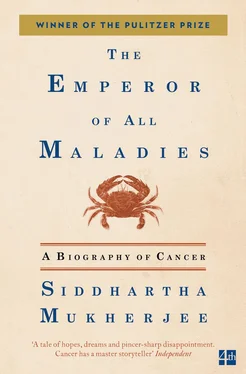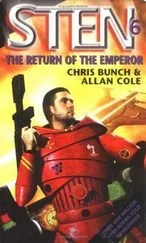Lister thought of a distant, seemingly unrelated experiment. In Paris, Louis Pasteur, the great French chemist, had shown that meat broth left exposed to the air would soon turn turbid and begin to ferment, while meat broth sealed in a sterilized vacuum jar would remain clear. Based on these observations, Pasteur had made a bold claim: the turbidity was caused by the growth of invisible microorganisms—bacteria—that had fallen out of the air into the broth. Lister took Pasteur’s reasoning further. An open wound—a mixture of clotted blood and denuded flesh—was, after all, a human variant of Pasteur’s meat broth, a natural petri dish for bacterial growth. Could the bacteria that had dropped into Pasteur’s cultures in France also be dropping out of the air into Lister’s patients’ wounds in Scotland?
Lister then made another inspired leap of logic. If postsurgical infections were being caused by bacteria, then perhaps an antibacterial process or chemical could curb these infections. It “occurred to me,” 141he wrote in his clinical notes, “that the decomposition in the injured part might be avoided without excluding the air, by applying as a dressing some material capable of destroying the life of the floating particles.”
In the neighboring town of Carlisle, Lister had observed sewage disposers cleanse their waste with a cheap, sweet-smelling liquid containing carbolic acid. Lister began to apply carbolic acid paste to wounds after surgery. (That he was applying a sewage cleanser to his patients appears not to have struck him as even the slightest bit unusual.)
In August 1867, a thirteen-year-old 142boy who had severely cut his arm while operating a machine at a fair in Glasgow was admitted to Lister’s infirmary. The boy’s wound was open and smeared with grime—a setup for gangrene. But rather than amputating the arm, Lister tried a salve of carbolic acid, hoping to keep the arm alive and uninfected. The wound teetered on the edge of a terrifying infection, threatening to become an abscess. But Lister persisted, intensifying his application of carbolic acid paste. For a few weeks, the whole effort seemed hopeless. But then, like a fire running to the end of a rope, the wound began to dry up. A month later, when the poultices were removed, the skin had completely healed underneath.
It was not long before Lister’s invention was joined to the advancing front of cancer surgery. In 1869, Lister removed a breast tumor 143from his sister, Isabella Pim, using a dining table as his operating table, ether for anesthesia, and carbolic acid as his antiseptic. She survived without an infection (although she would eventually die of liver metastasis three years later). A few months later, Lister performed an extensive amputation 144on another patient with cancer, likely a sarcoma in a thigh. By the mid-1870s, Lister was routinely operating on breast cancer and had extended his surgery to the cancer-afflicted lymph nodes under the breast.

Antisepsis and anesthesia were twin technological breakthroughs that released surgery from its constraining medieval chrysalis. Armed with ether and carbolic soap, a new generation of surgeons lunged toward the forbiddingly complex anatomical procedures that Hunter and his colleagues had once concocted on cadavers. An incandescent century of cancer surgery emerged; between 1850 to 1950, surgeons brazenly attacked cancer by cutting open the body and removing tumors.
Emblematic of this era was the prolific Viennese surgeon Theodor Billroth. Born in 1821, Billroth studied music and surgery with almost equal verve. (The professions still often go hand in hand. Both push manual skill to its limit; both mature with practice and age; both depend on immediacy, precision, and opposable thumbs.) In 1867, as a professor in Berlin, Billroth launched a systematic study of methods to open the human abdomen to remove malignant masses. Until Billroth’s 146time, the mortality following abdominal surgery had been forbidding. Billroth’s approach to the problem was meticulous and formal: for nearly a decade, he spent surgery after surgery simply opening and closing abdomens of animals and human cadavers, defining clear and safe routes to the inside. By the early 1880s, he had established the routes: “The course so far is already 145sufficient proof that the operation is possible,” he wrote. “Our next care, and the subject of our next studies, must be to determine the indications, and to develop the technique to suit all kinds of cases. I hope we have taken another good step forward towards securing unfortunate people hitherto regarded as incurable.”
At the Allgemeines Krankenhaus, the teaching hospital in Vienna where he was appointed a professor, Billroth and his students now began to master and use a variety of techniques to remove tumors from the stomach, colon, ovaries, and esophagus, hoping to cure the body of cancer. The switch from exploration to cure produced an unanticipated challenge. A cancer surgeon’s task was to remove malignant tissue while leaving normal tissues and organs intact. But this task, Billroth soon discovered, demanded a nearly godlike creative spirit.
Since the time of Vesalius, surgery had been immersed in the study of natural anatomy. But cancer so often disobeyed and distorted natural anatomical boundaries that unnatural boundaries had to be invented to constrain it. To remove the distal end of a stomach filled with cancer, for instance, Billroth had to hook up the pouch remaining after surgery to a nearby piece of the small intestine. To remove the entire bottom half of the stomach, he had to attach the remainder to a piece of distant jejunum. By the mid-1890s, Billroth had operated on forty-one patients with gastric carcinoma using these novel anatomical reconfigurations. Nineteen of these patients had survived the surgery.
These procedures represented pivotal advances in the treatment of cancer. By the early twentieth century, many locally restricted cancers (i.e., primary tumors without metastatic lesions) could be removed by surgery. These included uterine and ovarian cancer, breast and prostate cancer, colon cancer, and lung cancer. If these tumors were removed before they had invaded other organs, these operations produced cures in a significant fraction of patients.
But despite these remarkable advances, some cancers—even seemingly locally restricted ones—still relapsed after surgery, prompting second and often third attempts to resect tumors. Surgeons returned to the operating table 147and cut and cut again, as if caught in a cat-and-mouse game, as cancer was slowly excavated out of the human body piece by piece.
But what if the whole of cancer could be uprooted at its earliest stage using the most definitive surgery conceivable? What if cancer, incurable by means of conventional local surgery, could be cured by a radical, aggressive operation that would dig out its roots so completely, so exhaustively, that no possible trace was left behind? In an era captivated by the potency and creativity of surgeons, the idea of a surgeon’s knife extracting cancer by its roots was imbued with promise and wonder. It would land on the already brittle and combustible world of oncology like a firecracker thrown into gunpowder.
Конец ознакомительного фрагмента.
Текст предоставлен ООО «ЛитРес».
Прочитайте эту книгу целиком, купив полную легальную версию на ЛитРес.
Безопасно оплатить книгу можно банковской картой Visa, MasterCard, Maestro, со счета мобильного телефона, с платежного терминала, в салоне МТС или Связной, через PayPal, WebMoney, Яндекс.Деньги, QIWI Кошелек, бонусными картами или другим удобным Вам способом.













